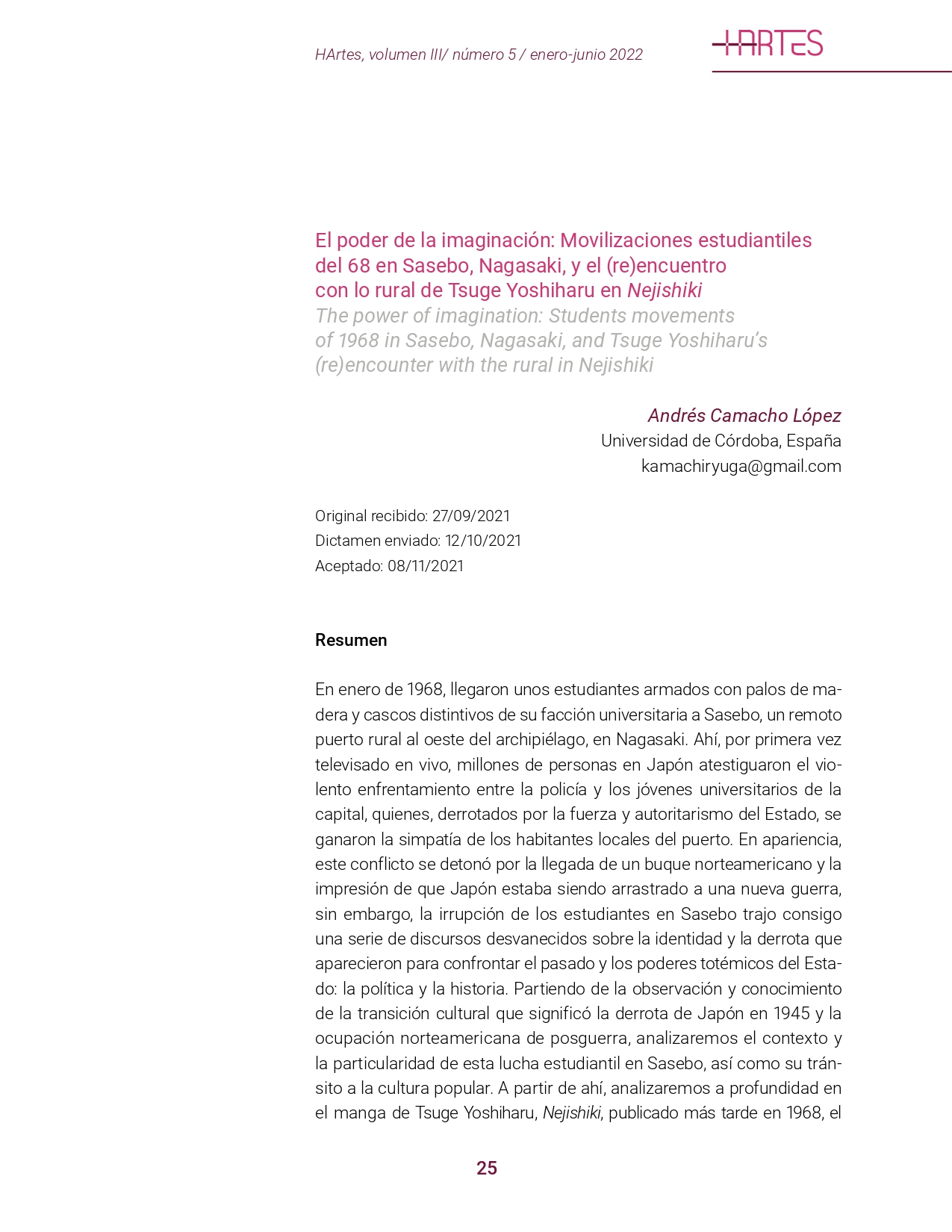Abstract
In January of 1968, a small group of students armored with wooden staves and colorful helmets distinguished by their university’s faction, arrived at Sasebo, a remote rural port in Nagasaki, Japan. For the first time broadcasted live on T.V. all over Japan, millions of people witnessed the violent clash between the police and the university students who, apparently defeated by the force and authoritarianism of the State, received the rural port local’s sympathy. Apparently, this conflict had its roots on the arrival of the U.S. aircraft to the port and the sensation of Japan being pushed to a new war, but it was rather the irruption of the students in the rural port that evoked vanished discourses to confront the past and settle the conflict with the totemic powers of the State: politics and history. Thus, observing and recognizing this important moment in the cultural transition that meant the war’s defeat in 1945 and the North American occupation in postwar Japan, we will analyze the context and particularity of the student’s struggle in Sasebo, as well as its transit to pop culture. From there, we will deeply analyze how is aesthetically adapted in Tsuge Yoshiharu’s manga Nejishiki (1968), the irruption of youth and its reencounter, sometimes uncanny, with rural Japan, a remote space vanished by modernity that was reshaped in the Japanese imaginary as the origin and return, namely home (furusato).
References
Andrews, W. (2016). Dissenting Japan, A history of Japanese Radicalism and Counterculture, from 1945 to Fukushima. Reino Unido: C. Hurst & Co.
Amino, Y. (2012). Rethinking Japanese History. Estados Unidos: University of Michigan
Benesch, O. (2014). Inventing the Way of the Samurai: Nationalism, Internationalism, and Bushidō in Modern Japan. Reino Unido: Oxford University Press.
Cassegard, C. (2008). From Withdrawal to Resistance. The Rhetoric of Exit in Yoshimoto Takaaki and Karatani Kojin. Revista The Asia Pacific Journal, 6 (3), 1-22.
Echeverría, B. (2011). Modernidad y Blanquitud. Ciudad de México: Era.
Garon, S. (1993). The World’s Oldest Debate? Prostitution and the State in Imperial Japan, 1900-1945. The American Historical Review, 98(3), pp. 710-732.
Gravett, P. (2004). Manga: Sixty Years or Japanese Comic. Reino Unido: Laurence King.
Iida, Y. (2002). Rethinking Identity in Modern Japan: Nationalism as Aesthetics. Estados Unidos: Routledge.
Ivy, M. (1989). Critical Texts, Mass Artifacts: The Consumption of Knowledge in Postmodern Japan. Masao Miyoshi y H.D. Harootunian (eds.) Postmodernism and Japan. Reino Unido: Duke University Press. 21-46.
_____. (1995). Discourses of the Vanishing: Modernity phantasm Japan. Estados Unidos: University of Chicago Press.
Karatani, K. (1993). Origins of modern Japanese literature (postcontemporary interventions). Reino Unido: Duke University Press.
Kelman, P. (2001). Protesting the national identity: The cultures of protest in 1960´s Japan. Australia: Universidad de Sidney.
Kinsella, S. (2000). Adult Manga, Culture and Contemporary Japanese Society. Reino Unido: Curzon Press.
Kitano R. (1990) Playback (Pureibakku). Japón: Kodansha.
Klaus, A. (1991). Momotarō (The Peach Boy) and the Spirit of Japan: Concerning the Function of a Fairy Tale in Japanese Nationalism of the Early Shōwa Age. Asian Folklore Studies, 50(1), pp. 155-188.
Löwe, M. (2003). Walter Benjamin: Aviso de incendio. Una lectura de la tesis sobre el concepto de historia. Argentina: Fondo de Cultura Económica de Argentina.
Marotti, W. (2009). Japan 1968: The performance of violence and the theater of violence. Estados Unidos: AHR Oxford University Press.
MacCannell, D. (1999). The Tourist: A New Theory of the Leisure Class. Los Angeles: University of California Press.
Mayer, F. H. (1960). Character Portrayal in the Japanese Folk Tale. Anthropos, 55(5/6), pp. 665-670.
Monsiváis, C. (2011). El 68. La tradición de la resistencia. México: Ediciones Era.
Meyer, M. (2015). The Night Parade of One Hundred Demons: A Field Guide to Japanese Yokai. Estados Unidos: Matthew Meyer.
Monsiváis, C. (1981). Notas sobre el Estado y la cultura nacional. Cuadernos Políticos, (30), pp. 33-52.
Montenegro, B.V. (2011). Representación e ilusión. El «como si» en Kant, Nietzsche y Derrida. Revista Pléyade 7, 4 (1), pp. 227-240.
Morris, I. (2014). The nobility of Failure. Reino Unido: Kurodahan press.
Ōguma, E. (2015). Japan’s 1968: A Collective Reaction to Rapid Economic Growth in an Age of Turmoil 日本の 1968 混乱期の高度成長への共同体的反 応. Revista The Asia-Pacific Journal, 13 (12), 1-18.
_____. (2018). What was and is ‘1968’? Japanese Experience in Global Perspective. Revista The Asia-Pacific Journal, 16 (11), pp. 1-18.
Ohnuki-Tierney, Emiko (2002). Kamikaze Cherry Blossoms and Nationalisms: The Militarization of Aesthetics in Japanese History. Estados Unidos: The University of Chicago Press.
Oyler, E. (2006). Swords, Oaths and Prophetic Visions: Authoring Warrior Rule in Medieval Japan. Estados Unidos: University of Hawai’i Press
Steinhoff, P. (2013). Memories of New Left protest. Revista Contemporary Japan, 25 (2), pp. 127-165.
Pellegrini, M. (1982). La imaginación al poder: París Mayo 1968. España: Argonauta.
Pérez, F. (2012). El principio (1968 – 1988: años de rebeldía). México: Para Leer en Libertad.
Pinguet, M. (2016). La muerte voluntaria en Japón. Argentina: Adriana Hidalgo Editora.
Revueltas, J. (2013). México 68: juventud y revolución. México: Ediciones Era.
Sartre, J. (1984). Being and Nothingness, An Essay on Phenomenological Ontology. Estados Unidos: Philosophical Library.
Saruya H. (2012). Protests and Democracy in Japan: The Development of Movement Fields and the 1960 Anpo Protests. Estados Unidos: Universidad de Michigan.
Sas, M. (2012). Moving the Horizon: Violence and Cinematic Revolution in Ōshima Nagisa’s Ninja bugeichō. Mechademia, 7, pp. 264-280.
Tsuge, Y. (1968, junio). Nejishiki. Revista Garo, num. 47, pp. 3-25

This work is licensed under a Creative Commons Attribution-NonCommercial 4.0 International License.
Copyright (c) 2022 HARTES

